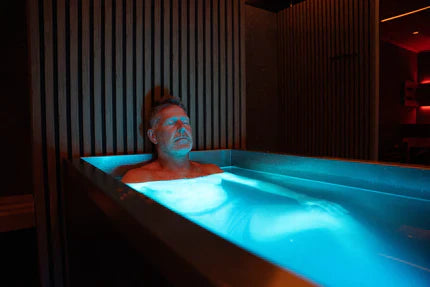After a sweaty workout, the body often feels heavy, the muscles sore and the brain... well, rather mushy. We stretch a bit, maybe drink a protein shake, and tell ourselves that "it'll be fine until tomorrow".
But what if you could do something that actually help your body recover faster - for real?
Here comes ice bath comes into play. As brutal as it sounds, it's just as effective. And we promise - it's not just for elite athletes and winter swimmers on Instagram.
Why ice baths after exercise?
Exercise breaks down the body. It may sound crazy, but it's true. Muscles are torn, small inflammations occur, and the body is put under stress. That's how we get stronger - by rebuilding the body, a little better each time.
But that process requires something that many of us miss:
Recovery.
And that's where the ice bath comes in - as a turbo tool to:
-
Reducing inflammation
-
Alleviating exercise pain
-
Increase blood circulation
-
Lowering stress levels
What happens in the body during an ice bath?
When you immerse your body in ice-cold water (preferably around 8-12 degrees), your body reacts immediately:
Acute hypothermia = vasoconstriction
Blood vessels contract rapidly to protect your vital organs. This allows blood to flow away from the skin and into deeper tissues.
It's a bit like pressing a 'reset button' for the body's stress system.
After the bath = blood flow boost
When you get out of the water, something cool happens: the vessels open up again and the blood rushes back. This reaction:
-
Rinses away waste products accumulated in the muscles
-
Bring in oxygen and nutrients
-
Starts the body's own healing process
All this happens naturally. No supplements, no pills - just you, your body and some cold water.
Benefits of ice baths after exercise
So, why do so many people nowadays finish their workouts with a dip in an ice bath? Here are the biggest benefits.
1. Reduction of pain during exercise (DOMS)
After heavy leg work or running on a hill? Then you know what exercise pain means. Ice baths can:
-
Reduce the experience of exercise pain
-
Shortens the time you feel stiff and tired
-
Helping you get back on track faster
2. Better recovery = better performance
If you exercise several times a week, fast recovery is is crucial. Ice baths help to:
-
Reduce muscle fatigue
-
Increasing persistence over time
-
Getting your body ready for the next session faster
3. less inflammation
All exercise creates micro-injuries. It's not dangerous - but if you never let your body recover, you risk overload and injury.
Ice baths reduce inflammation and give the body a chance to repair itself more effectively.
Bonus: Ice baths for mental recovery
Exercise doesn't just affect your body. It also takes a toll on the mind - especially if you combine it with young children, work, lack of sleep and stress.
Cortisol down, dopamine up
After an ice bath, studies show that:
-
Cortisol (stress hormone) decreases
-
Dopamine (pleasure hormone) increases sharply
-
You feel clearer, calmer and more balanced
It's a bit like a cold bath for the soul too, not just the body.
How to make an ice bath at home - step by step
You don't need a purpose-built barrel in the garden or a spa.
How often should you do ice baths after exercise?
For best effect:
-
2-3 times a week if you exercise frequently
-
After particularly hard workouts
-
Or when you feel extra sluggish in your body
The most important thing is regularity - a little, often rather than a lot, rarely.
Why Swedish Cold makes a difference after exercise
With Swedish Cold, you can choose the exact temperature down to minus degrees. This means that you can:
-
Fine-tune the temperature according to the day and the desired effect
-
Avoid panic baths - but get the maximum effect
-
Training the body step by step to tolerate colder degrees without shock
Unlike natural baths and other systems that only reach down to 3°C, Swedish Cold offers active cooling below 0°C. It creates ice cubes in the water - giving you a controlled, powerful cold exposure right after the gym, run or crossfit session.
The effect? You recover faster, sleep better, and get your legs back faster - without leaving home.
Which ice bath is the best ice bath? If you want to read more about which ice bath is the best, you can do so on this page: There are also best in test pages on this Danish site; See the link here.
There is also another best in test site for ice baths called Testexpert.com, see link here ;

